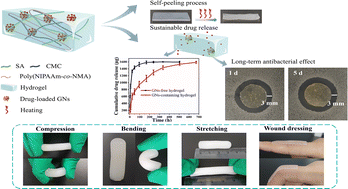Vancomycin-loaded hydrogels with thermal-responsive, self-peeling, and sustainable antibacterial properties for wound dressing†
Abstract
Wound dressings play an important role in wound healing. However, many wound dressings lack antibacterial properties and are difficult to remove from newly grown tissues, causing secondary wound injuries and repeated medical treatment. This study reports a new type of thermal-responsive hydrogel dressing consisting of vancomycin-loaded gelatin nanospheres (GNs) and poly((N-isopropylacrylamide)-co-N-(methylol acrylamide)) functional components that could impart self-peeling and sustainable antibacterial properties. SEM images showed that the prepared hydrogel possessed a porous microstructure and the homogeneous distribution of GNs in its network. Excellent swelling ratios and thermal-induced self-peeling characteristics were confirmed by qualitative analysis. The GNs not only enhanced the strain at break of the hydrogel, but also acted as drug carriers to slow down the drug release from the hydrogel, achieving sustainable antibacterial properties and balanced biocompatibility. Therefore, this vancomycin-loaded hydrogel with self-peeling characteristics provides an effective way of preventing wound infection and can be used as a novel platform for wide-ranging applications of wound dressings.



 Please wait while we load your content...
Please wait while we load your content...